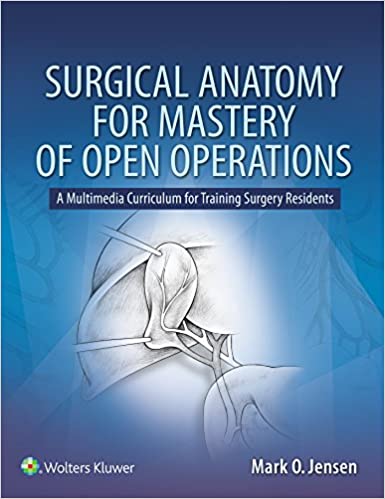Surgical Anatomy for Mastery of Open Operations (2018) is a guide to surgical anatomy and technique. While it’s not the first book of its kind, it does have several important features that make it one of the better ones in its genre. The diagrams are crisp and instructive, and the text is similarly instructive and clear. (I cannot post pictures here because of copyright considerations. That said, the drawing on the cover below is a rather typical image. If you’d like to see more, check out the book excerpts at Google Books or Amazon.)
All surgeries take place in the three dimensions of space, and in a particular sequence, that is, in the fourth dimension of time. So you can’t really understand surgery by reading a book. This is why Surgical Anatomy for Mastery of Open Operations (2018) comes with excellent cadaveric surgery videos—free sample here—which help make the text come to life in the mind of the reader.

While I like the content of the book, I’m not too excited about its structure. You see, even though it’s only about 250 pages long, it reads too much like a textbook. For example, the operative part of emergency cricothyroidotomy is described this way:
Use a Kelly, mosquito, or right-angle clamp to spread tissues in the midline. Use the introducer needle to penetrate the cricothyroid membrane and immediately angle the needle in an inferior direction in alignment with the airway (Fig. 1.10). A guide wire is inserted. Hooked dilators are placed in size succession smallest to largest. Be sure to begin dilator insertion over the wire perpendicular to the skin. Rotate the dilator clockwise and counterclockwise to “screw” it into the airway.
Surgical Anatomy for Mastery of Open Operations (2018), pages 8-9
There are several issues here. First, surgeons plan procedures in steps. (“Checklists seem able to defend anyone, even the experienced, against failure in many more tasks than we realized.” ~ The Checklist Manifesto). So it would be helpful if future editions of this book laid things out with numbered items (see example below) rather than by clustering the information into dense paragraphs. This way, trainees can rehearse things in their mind more easily before operations. Second, did you notice all the passive language in the text (e.g., “a guide wire is inserted” and “hooked dilators are placed,” etc.)? This passive phrasing weakens the text and is un-conducive to effective learning and memorization. In future editions I’d much rather see active language in a numbered list format. For example, something like this might be much more effective:
- Use a Kelly, mosquito, or right-angle clamp to spread tissues in the midline.
- Use the introducer needle to penetrate the cricothyroid membrane and immediately angle the needle in an inferior direction in alignment with the airway (Fig. 1.10).
- Insert a guide wire.
- Place hooked dilators in size succession, from smallest to largest.
These types of changes would require almost line by line editing and revision of the text. However, all the content is already there, so I don’t think the task would would be too difficult for a medical editor of average ability.
So while I believe that there’s still work that needs to be done to bring this text to top-notch level, Surgical Anatomy for Mastery of Open Operations (2018) is, as is, among the best in its genre, and I therefore recommend it very highly to surgery residents and to medical students who have a keen interest in general surgery.


Leave a Reply